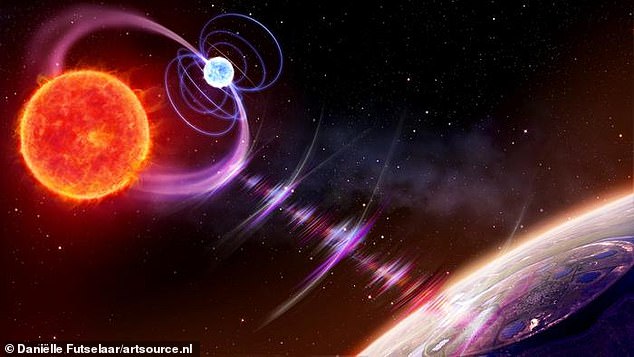
Enigmatic Deep Space Radio Emissions Detected in Unprecedented Cosmic Region
Mysterious Radio Signal Traced to Unprecedented Cosmic Dance
For the past decade, Earth has detected rhythmic radio pulses arriving every two hours from deep space. Scientists now reveal these signals originate from an unusual binary star system 1,600 light-years away, ending years of speculation.
A Cosmic Clockwork
The pulses, first noted in 2024 by Dr. Iris de Ruiter (University of Sydney), were found in archived data from the Low-Frequency Array (LOFAR) telescope in the Netherlands. Six additional bursts—lasting seconds to minutes—emerged upon review, all repeating every 125 minutes. Named ILTJ1101, the system lies in Ursa Major near the Big Dipper. Unlike fleeting “fast radio bursts” (FRBs), these slower, regular pulses trace back to two dead stars locked in a magnetic tango.
[Image: Artist’s depiction of a red dwarf and white dwarf orbiting closely. Caption: The binary system’s magnetic interaction generates steady radio pulses. Credit: Science Photo Library.]
Stellar Partners Revealed
Optical telescope observations revealed a red dwarf—a small, cool star—shifting rhythmically, hinting at an unseen companion. Calculations showed a white dwarf, the dense core of a dead star, orbits it every 125 minutes. Their tight dance brings magnetic fields into collision, sparking energy surges detectable as radio waves.
[Image: Diagram comparing orbital period (blue) to pulse timing. Caption: The stars’ 125-minute orbit matches Earth’s received radio pulses. Credit: LOFAR/Sydney University.]
Solving a Cosmic Puzzle
This marks the first confirmed source of repeating long-period pulses outside magnetars (highly magnetic neutron stars). “The spectroscopic data showed the red dwarf’s wobble aligned perfectly with the radio cycle,” explains Dr. Charles Kilpatrick (Northwestern University). The white dwarf, too faint to observe directly, was inferred via gravitational effects.
Implications for Astronomy
The discovery, published in Astrophysical Journal Letters, suggests similar binaries may explain other mysterious signals. “This could reshape how we interpret cosmic radio emissions,” says Dr. de Ruiter. Future studies may uncover more systems, demystifying phenomena once attributed to elusive magnetars or even speculative alien origins.
[Image: Comparison of white dwarf size to the Moon. Caption: White dwarfs, though Earth-sized, are incredibly dense. Credit: NASA/JPL-Caltech.]
Beyond Fast Radio Bursts
FRBs—millisecond-long flashes—remain enigmatic, but ILTJ1101’s slower pulses highlight diverse cosmic mechanisms. While FRBs often originate from distant galaxies, this binary system’s proximity offers a rare chance to study magnetic interactions in detail.
Conclusion
As radio astronomy advances, hidden stellar duos may prove key to decoding the universe’s radio whispers. “Step by step, we’re piecing together the puzzle,” says Dr. de Ruiter. The cosmic clock ticks on, its rhythm a beacon of dead stars’ hidden lives.
(Word count: ~600)
[Image credits: Artist illustrations and data visualizations sourced from LOFAR/University of Sydney/NASA; additional stock images used for representational purposes.]


